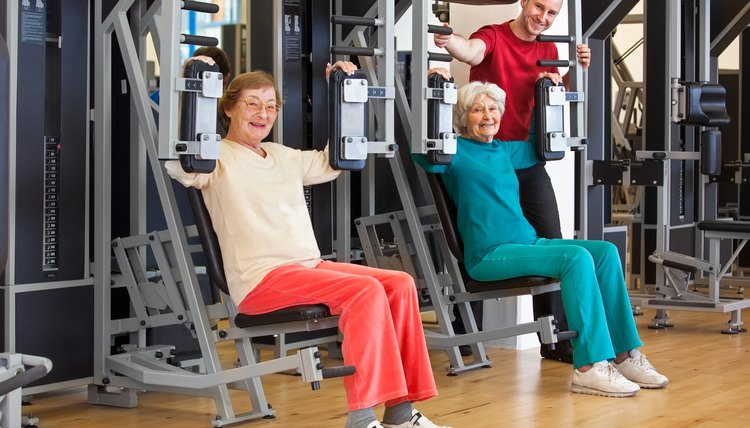Circuit Training for Seniors

Health organizations such as the American College of Sports Medicine and the Centers for Disease Control and Prevention strongly urge older adults to exercise regularly. Cardiovascular training maintains and improves heart health, stamina and your blood lipid profiles. Strength and balance training keep your bones and muscles strong, make daily activities easier and prevent falls. Circuit training incorporates all of these training modes into a time-efficient and effective workout format that is often used in senior fitness programming at health clubs.
Circuit Creativity
There are many ways you can design your circuit workout. First, determine the total time you can dedicate to your session. This may depend on your current fitness level. Start with at least a 10-minute session, and eventually, work your way up to a 30- to 60-minute session if possible. Next, decide how many exercises you will perform. Circuits often include eight to 10 exercises, but can consist of more or fewer stations. Depending on how long you plan to exercise, decide how many rounds of the circuit you will complete and how long you will perform each circuit. Each station can be performed for an equal time period, or you can vary the intervals for cardiovascular, strength and balance exercises.
Move the Muscles
Seniors should perform strength exercises at least twice a week to maintain muscular strength and bone mineral density. Strength exercises can be performed with body weight, elastic resistance such as bands or tubing, dumbbells or other resistance-training equipment such as cable machines. Select enough exercises so that each major muscle group of the body is targeted. Be sure that your interval length allows you to complete at least 10 to 15 repetitions of each strength exercise. If time is a factor, choose exercises that target more than one muscle group such as a squat and biceps curl to shoulder press combination. If you are new to strength training, select seated exercises first and build up your core strength before progressing to more challenging exercises.
Increase Your Heart Rate
Aerobic exercise is critical for seniors to improve cardiovascular health and decrease your risk of heart-related diseases. Any exercise that is repetitive and rhythmic in nature can be considered aerobic activity. The traditional aerobic options such as walking and biking will work well if you have exercise equipment or are completing your circuit on a walking trail. Alternative aerobic choices could be calisthenic exercises such as marching in place, alternating knee lifts or front kicks or your favorite dance moves.
Balance and Stability
Your risk of losing balance and falling increases as you age, mainly related to decreases in strength and stability. Therefore, it is important to challenge your balance and try exercises that feel a little unstable to improve in these areas. Certain strength exercises, such as the lunge, may already pose a balance challenge. However, you can also add other drills for this category such as standing on one foot, various yoga balancing poses or sitting on a stability ball. Be mindful to keep your environment safe while doing unstable exercises, and have something to hold on to in case you need a balance check.
References
Writer Bio
Christine St. Laurent holds a Master of Science in kinesiology from James Madison University. She has worked in hospital, university, sports performance and spa-based fitness and wellness centers as a personal trainer, program leader and group fitness instructor. St. Laurent has also taught college-level courses in exercise science. She is the owner of a personal-training and group-exercise studio in Manchester, Conn.
